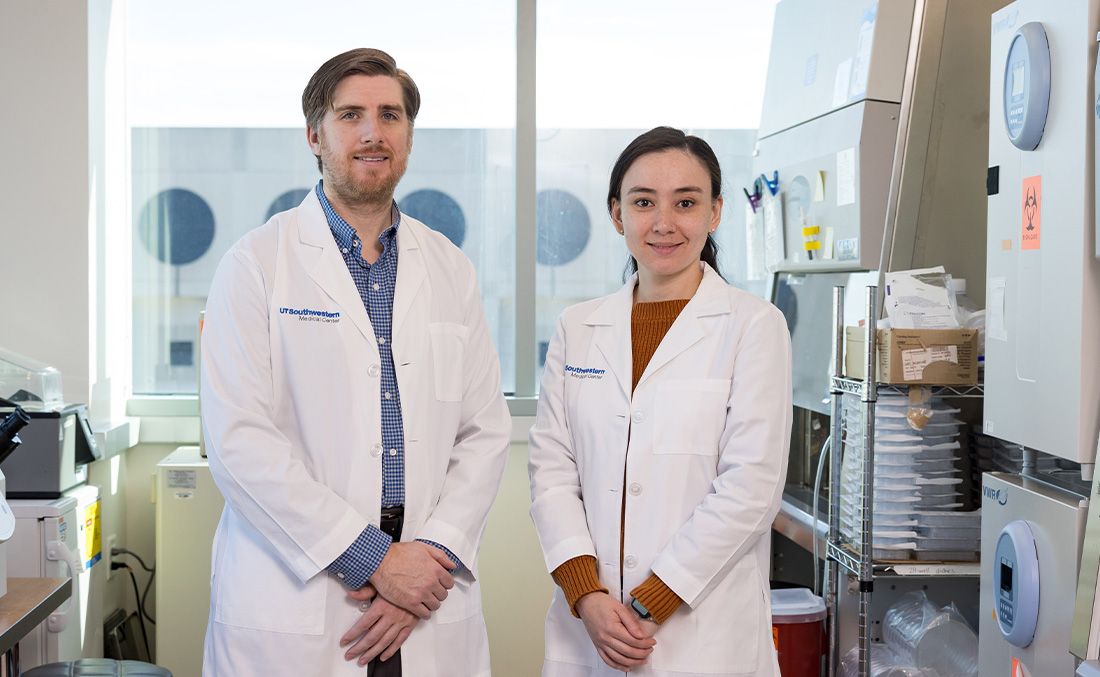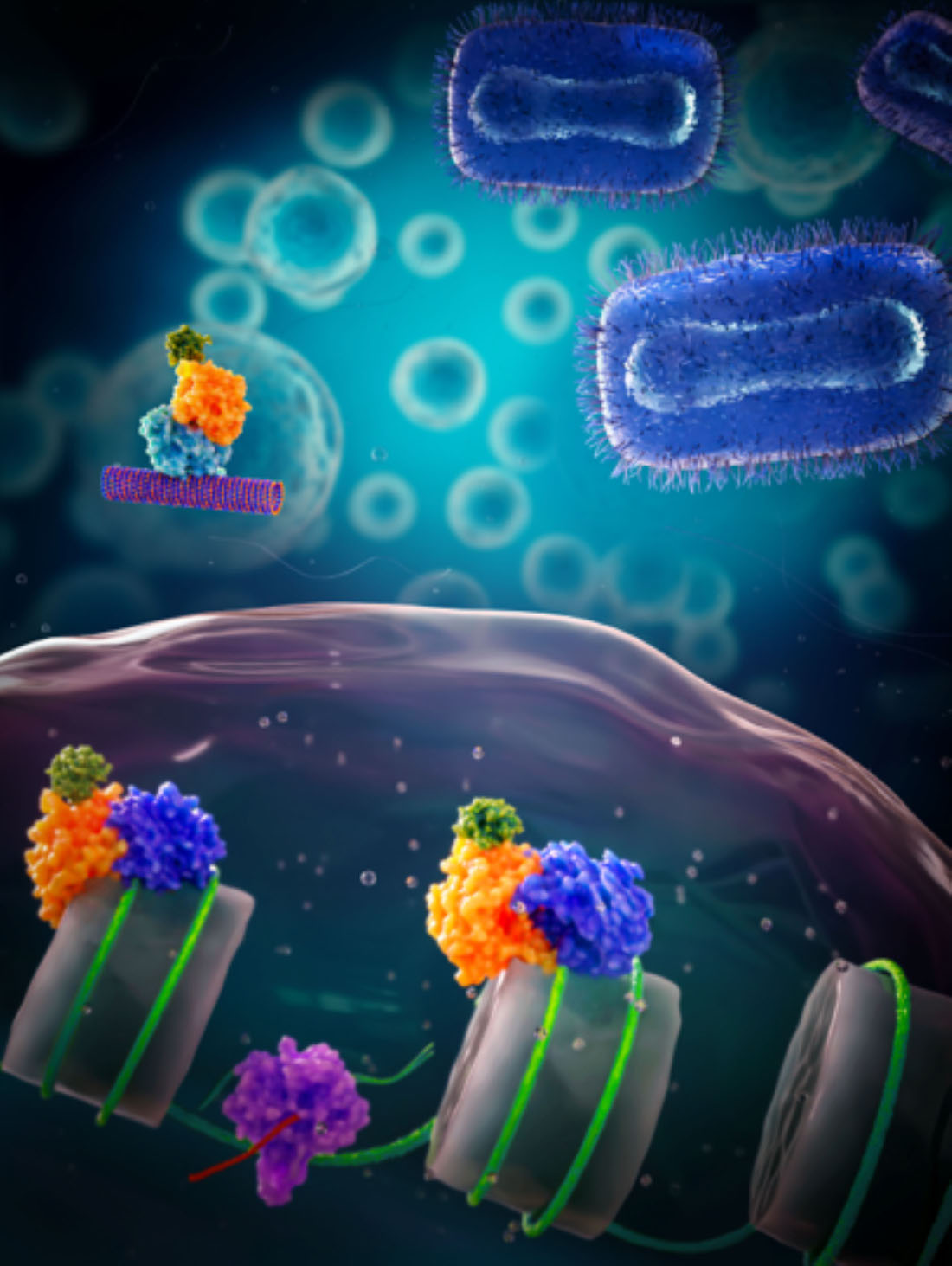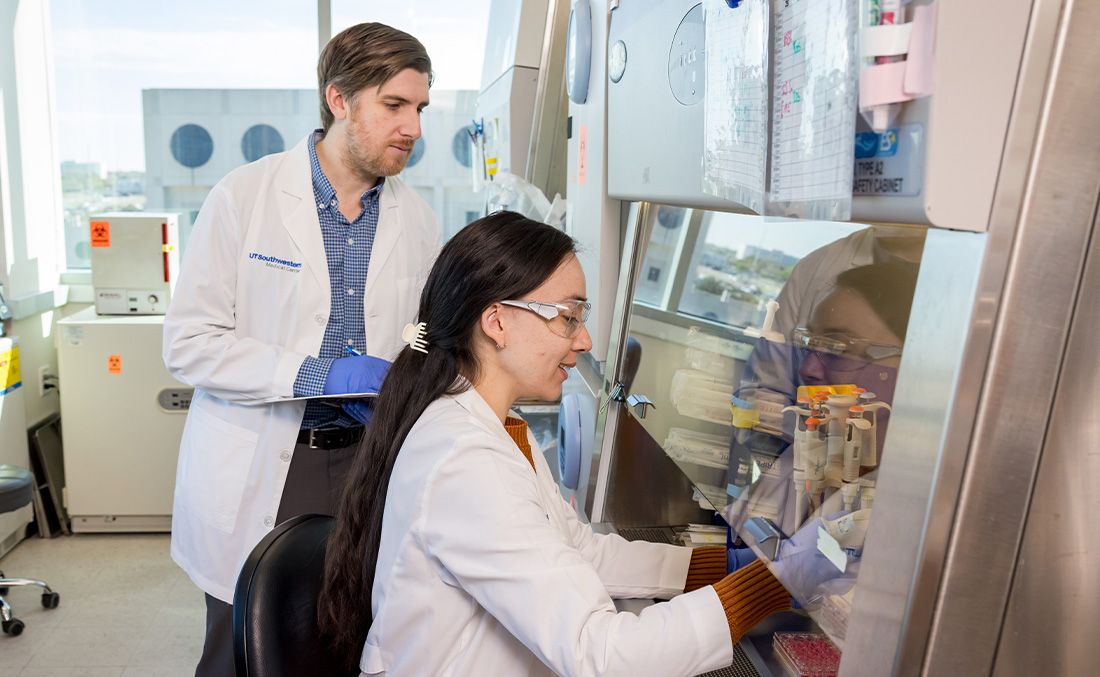UT Southwestern scientists discover antiviral immune pathway
Finding suggests new avenues for research related to role in fighting an array of viruses

DALLAS – April 03, 2024 – By focusing on a poxvirus protein, a team led by UT Southwestern Medical Center scientists has discovered an antiviral immune pathway that broadly fights a wide variety of viruses. Their findings, reported in Nature Microbiology, could eventually lead to new ways to prevent or treat viral infections or thwart autoimmune diseases.
“To learn how immune responses work, we let the viruses do the talking. This pathogen-guided approach has led us to an immune response pathway that was previously unknown,” said Don Gammon, Ph.D., Assistant Professor of Microbiology and a W.W. Caruth, Jr. Scholar in Biomedical Research at UT Southwestern. Dr. Gammon co-led this study with Emily Rex, a graduate student researcher at UTSW and former manager in the Gammon Lab.
Nearly a decade ago, when Dr. Gammon was a postdoctoral fellow under the mentorship of Nobel Laureate Craig Mello, Ph.D., at the University of Massachusetts Medical School, he and his colleagues found that viruses that don’t typically replicate in moth cells did so readily when co-infected with vaccinia virus, a poxvirus that usually infects vertebrates. Genetic manipulations showed this effect was due to a poxvirus protein called A51R, which appeared to act as an immune evasion protein that helps these viruses counter cellular antiviral defenses. It was unclear why a mammalian poxvirus protein would be capable of inhibiting antiviral responses in insect cells.

Dr. Gammon hypothesized that poxvirus A51R proteins were likely inhibiting an antiviral defense that is common between insect and mammalian hosts. However, the nature of this antiviral response and the mechanism by which A51R blocked this response was unknown.
In the new study, Dr. Gammon, Ms. Rex, and their colleagues sought answers by searching for proteins in mammalian cells that bind to A51R. Their experiments showed A51R attached to Spt16, a protein known to join with another cellular protein (SSRP1) to form a unit called the FACT complex. Further experiments showed that when A51R was present in cells, as during a poxvirus infection, it prevented this complex from forming, blocking it from doing its job regulating gene activity by activating another protein (ETS-1) in the cell nucleus.
Although the FACT complex had never been connected to antiviral immunity, further experiments showed that the genes it regulates through ETS-1 have antiviral functions. Surprisingly, this previously unknown antiviral pathway – which the researchers named the FACT-ETS-1 Antiviral Response (FEAR) pathway – has no connection to the interferon response pathway, which was discovered in 1957 and has been thought to be the major way mammalian cells fight off viruses.
The interferon response is present only in vertebrate cells, but both the FACT complex and ETS-1-related factors are found in many organisms, including humans, bats, insects, and worms, suggesting the FEAR pathway may be evolutionarily much older than the interferon response. The FEAR pathway also appears to work against a broad array of viruses in different families, including rhabdoviruses (which cause rabies), flaviviruses (which cause Zika, dengue, and yellow fever), and orthomyxoviruses (which cause influenza).
Much remains to be learned about this newly discovered immune pathway, Dr. Gammon said, including how FEAR is activated by viruses, how other viruses inhibit it, and how it blocks viral replication at the molecular level. A deeper understanding of FEAR could lead to better vaccines, new drugs to fight viral infection, or new ways to treat autoimmune diseases if FEAR is found to be activated in these conditions, he added.
Other UTSW researchers who contributed to this study include Neal Alto, Ph.D., Professor of Microbiology; Robert Orchard, Ph.D., Assistant Professor of Immunology and Microbiology; Dustin Hancks, Ph.D., Assistant Professor of Immunology; Sruthi Chappidi, Ph.D., Computational Biologist; and graduate student researchers Dahee Seo, Aaron Embry, and Moiz Munir.
Ms. Rex is a recipient of National Institutes of Health (NIH) T32 Molecular Microbiology Training Grant funding and a Stein-Streilein Scholarship.
Dr. Alto holds the Lorraine Sulkin Schein Endowed Distinguished Professorship in Microbial Pathogenesis and is a Rita C. and William P. Clements, Jr. Scholar in Medical Research and a UT Southwestern Presidential Scholar. He is also a member of the Harold C. Simmons Comprehensive Cancer Center.
Dr. Orchard holds the Nancy Cain and Jeffery A. Marcus Scholar in Medical Research, in Honor of Dr. Bill S. Vowell.

This study was funded by the NIH (1R21AI144203-01, 1R35GM137978-01, 1R35GM142689-01, and T32 AI007520), The Welch Foundation (I-2062-20210327), and the Cancer Prevention and Research Institute of Texas (RR 170047).
About UT Southwestern Medical Center
UT Southwestern, one of the nation’s premier academic medical centers, integrates pioneering biomedical research with exceptional clinical care and education. The institution’s faculty members have received six Nobel Prizes and include 25 members of the National Academy of Sciences, 21 members of the National Academy of Medicine, and 13 Howard Hughes Medical Institute Investigators. The full-time faculty of more than 3,100 is responsible for groundbreaking medical advances and is committed to translating science-driven research quickly to new clinical treatments. UT Southwestern physicians provide care in more than 80 specialties to more than 120,000 hospitalized patients, more than 360,000 emergency room cases, and oversee nearly 5 million outpatient visits a year.
